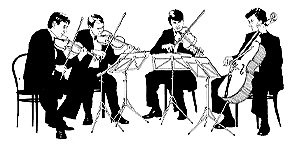Steven Ledbetter, BUPS
 Dimitri Shostakovich's Fifth Symphony, Op. 47, was his direct musical response to the charge of formalism brought down upon his head in the now famous article that appeared in Pravda in 1936. This charge was in reference to his great opera, Lady Macbeth of Mtsensk. The title of the article was "Muddle instead of Music." It accused Shostakovich of deliberate dissonance and a total absence of simple feeling, and it claimed that he created music that contained no memorable ideas. In the midst of the Stalinist era, while horrific purges wracked Russia, it was wise that Shostakovich took these charges seriously. He attempted to overcome his "formalistic" errors in earnest, especially since his colleagues in the Union of Soviet Composers endorsed the article's views. How truly sincere he was in this "new" approach towards music is still unclear, but he answered all of his critics' displeasure with the appearance of his Fifth Symphony. It premiered on November 21, 1937, was a huge success, and is today his most popular work. The four-movement structure is clearer than that of his earlier symphonies, the harmony is more tonal, and the themes are much more accessible, but the style is pure Shostakovich from the first note to the last.
Dimitri Shostakovich's Fifth Symphony, Op. 47, was his direct musical response to the charge of formalism brought down upon his head in the now famous article that appeared in Pravda in 1936. This charge was in reference to his great opera, Lady Macbeth of Mtsensk. The title of the article was "Muddle instead of Music." It accused Shostakovich of deliberate dissonance and a total absence of simple feeling, and it claimed that he created music that contained no memorable ideas. In the midst of the Stalinist era, while horrific purges wracked Russia, it was wise that Shostakovich took these charges seriously. He attempted to overcome his "formalistic" errors in earnest, especially since his colleagues in the Union of Soviet Composers endorsed the article's views. How truly sincere he was in this "new" approach towards music is still unclear, but he answered all of his critics' displeasure with the appearance of his Fifth Symphony. It premiered on November 21, 1937, was a huge success, and is today his most popular work. The four-movement structure is clearer than that of his earlier symphonies, the harmony is more tonal, and the themes are much more accessible, but the style is pure Shostakovich from the first note to the last.
Antonin Dvorak (born September 8, 1841, died May 1, 1904) is one of the greatest composers of the nationalist movement. He was born in what is now the Czech Republic and wrote music in practically every genre. It was Brahms who through important contacts was able to open doors and become responsible in large measure for Dvorak's later success. Dvorak's "American Period" lasted from 1892 to 1895 when he lived in New York City as head of a conservatory and spent his summers in Spillville, Iowa, where he wrote some of this greatest music. When the publishing house Simrock showed interest in publishing these pieces, it was Brahms who offered to correct the proofs before they went to print. The Violoncello Concerto in B Minor, Op. 104, was written during 1894 and 1895 by request from a man named Wihan. Being a string player himself and having played the viola in classical chamber works as well as to his own music, Dvorak was able to appreciate the musical and technical difficulties involved when writing for a solo instrument. These skills are especially necessary when writing for the solo cello. Because of its low range, the cello must be able to both delicately blend within the orchestral tapestry and confidently sing through it when necessary.
Speaking primarily of the creative orchestration (e.g., solo cello supported by three trombones in the Adagio) and the wonderfully inventive formal aspects (the dramatic omission of the first theme in the recapitulation of the first movement, as well as the recalling of the main theme of the first movement in the Coda of the finale), Brahms said admiringly that if he had known that such a concerto could have been written in this way he would have done so many years earlier.
Program for Tuesday, March 2
Conductor Ari Rasilainen
Cellist Martti Rousi
Dvorak: Cello Concerto in B Minor Op. 104
D. Skhostakovich: Symphony No.5 in D Minor Op.47
Faculty of Music and Performing Arts Auditorium, 9 pm.
For more information and reservations, call 266-4382.








